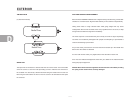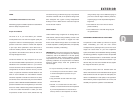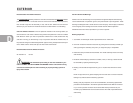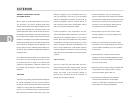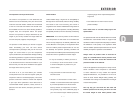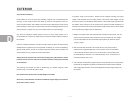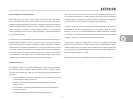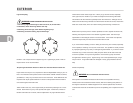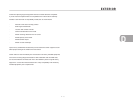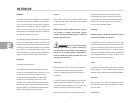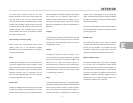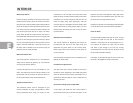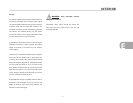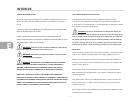
D
D - 13
EXTERIOR
Proper Inspection and Storage of Tires
Before taking your RV on a trip or when removing from an extended storage period,
make it a practice to inspect the overall condition of your tires. Check for any type of
condition or damage that might result in failure. A thorough check should include both
inside and outside sidewalls, tread area and the condition of hardware such as valve
stems, valve caps, and wheels. The tread should be checked for any unusual wear,
cracking, penetrations and/or cuts. An uneven wear pattern can indicate misalignment
or worn suspension parts.
Since many RVs are used seasonally and sometimes stored for extended times, it is
possible that tires will take many years to wear out. Tires, as any rubber product, will
age over time. If tires show cracking in the sidewall or tread surfaces that are more than
2/32nds deep, they should be replaced before your next trip or vacation. Store your RV
in a cool dry area away from major heat sources and extreme cold. An enclosed area is
best with no exposure to electromagnetic sources such as generators or transformers.
If you must keep your RV outside, cover your tires from direct sunlight. Take your RV to
your Tire dealer for service to check or correct any of these conditions.
Replacing Your Tires
It is possible to replace your tires with a different size in some instances to increase
your load capacity with a different inflation pressure. If there is a reason to replace
your tires with a different size, make sure the following checks are made before the
purchase.
• Does the replacement tire have the load capacity that is needed for my RV and
will it fit properly inside the wheel well?
• Will the overall diameter difference affect the speedometer or antilock
braking system?
• Is the increase in air pressure compatible with the maximum rated pressure
stamped on the rim?
• Is there enough dual spacing offset for the rear wheel positions?
Tires used on most RVs are driven at or near maximum loads during hot weather and
then are left idle for months. In normal use oils in the tire come to the surface during
flexing and protect the rubber from ultraviolet light. But when left idle natural aging may
cause the rubber to crack prematurely, especially in the sidewall area.
Any tire on an RV that is over five years old should be inspected by a competent tire
professional for cracking and replaced, even if it has no apparent tread wear. This is
because a tire on a car or truck might last 80,000 to 120,000 miles before it needs to
be replaced, but an RV tire that only travels 5,000 miles per year will not approach that
mileage for 20 years. It will need to be replaced much before that.
The first step is choosing a tire adequate for the load. The load rating printed on the
sidewall will show the maximum load that can be carried at a defined pressure. As the
inflation pressure drops, the load that can be carried is less. As speed increases, the
amount of load that can be carried also drops. The load rating is also affected by how
the tire is used, as a single or as a dual.
A Goodyear ST225/75 R15 tire inflated to 65 PSI has load capacity of 2540 Lbs.




